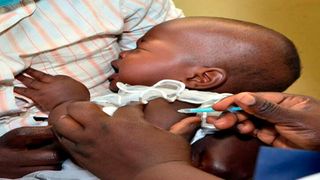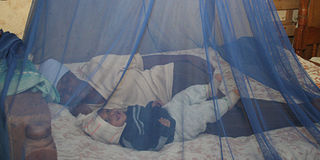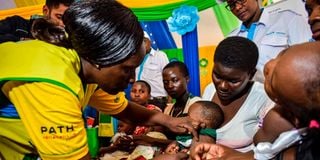
Seven-month-old Queensly Harriet receives her second dose of the malaria vaccine at Got Agulu Sub-County Hospital in Homa Bay County on April 16.
| Francis Nderitu | Nation Media GroupCounties
Premium
Why new malaria vaccine has lake region counties excited
Health workers in the lake region have welcomed the move by the World Health Organization (WHO) to approve the widespread use of a malaria vaccine among children in sub-Saharan Africa.
This is because the region is malaria-endemic, with most counties bearing the burden of the disease.
The vaccine, RTS, S, will be administered to children below the age of 24 months.
In September 2019, the Ministry of Health in partnership with WHO rolled out the world’s first malaria vaccine in a landmark phased introduction programme in parts of Kenya, Malawi and Ghana.

A mother and her baby sleep under a mosquito net.
In Nyanza, the pilot study took place in Homa Bay, Kisumu, Migori, Siaya, Vihiga, Bungoma, Busia and Kakamega counties, which are categorised as endemic areas.
The main aim of the study was to find out if the vaccine was safe and effective for children.
Kisumu County malaria programme manager Liliyana Dayo says the intervention will reduce the number of transmissions in the burdened counties.
“The announcement by WHO is indeed a big win for children in Kisumu County. Over the years, we have had reports of children displaying severe symptoms of malaria admitted in various health facilities while some succumbed to the disease,” she said.
In Kisumu, malaria transmissions happen throughout the year, Ms Dayo said.
“We often have surges among children aged five years and below during the rainy seasons between April and June, and September to early November,” she said.

A health worker administers the new malaria vaccine to a child in Homa Bay County, western Kenya in September 2019.
The pilot study, which began in 2019, saw the five sub-counties of Muhoroni, Seme, Kisumu West, Kisumu East and Kisumu Central take part while Nyando and Nyakach acted as control areas.
Before the pilot programme, Kisumu would report 50 to 60 admissions per month, with 70 percent of them as a result of malaria, said Salome Situma, a pediatric nurse at Jaramogi Oginga Odinga Teaching and Referral Hospital.
Hospital wards reported an influx of patients who displayed severe symptoms.
“The vaccine is a major intervention for reducing cases of the parasitic disease,” Ms Situma said.
Going by the malaria indicator survey of 2020 and the findings released in April 2021, the burden of the parasitic disease in the county has declined by 18 percent.
“The number of patient admissions suffering from malaria has also reduced to 10 in a month,” Ms Dayo said.
In Migori County, the pilot phase of the malaria vaccination was conducted in two sub-counties across 65 health facilities.
County Director of Public Health Kennedy Ombogo said 16,126 children had received the vaccine by June 2021.
“We are keen on cascading the programme to other sub-counties. The recent findings by WHO on the efficacy of the vaccine are a major boost in the fight against malaria,” Mr Ombogo told Nation.Africa, expressing confidence that the vaccine uptake will continue after the study.
“The trial has proven the efficacy of the vaccine. So far, we have witnessed a sharp decline in cases among the target group, although some are yet to complete the dosage,” he added.
Migori County malaria coordinator Florence Ngere, however, expressed concerns about some parents who are uncomfortable with the high number of injections. She called for proper sensitisation on the benefits of the vaccines.
“We have noted that some parents are uncomfortable with the four doses and sometimes skip clinics. What we need is community mobilisation to make them fully aware of the benefits of the vaccine in the fight against malaria,” she said.
Busia Chief Health Officer Collins Matemba, in an interview, confirmed that 40 per cent of patients who visit the health facilities are often diagnosed with malaria.
Eleven percent of those admitted in wards are also likely to be malaria patients, he said.
Despite several interventions to curb the infections, including the use of mosquito nets, the disease remains a major challenge.
“Malaria is still a top killer disease in the county. In every 100 children who die, 12 succumb to complications from the parasitic disease,” Dr Matemba said.
But he confirmed that the pilot study, conducted in three sub-counties, played a major role in reducing severe infection cases.
“The number of infections has greatly reduced. I hope that all the children in the county will be immunised to lessen the burden,” he said.
Homa Bay County immunisation services coordinator Christine Ongete said the vaccine has brought hope to residents, especially those who have underlying illnesses.
“Malaria remains a major cause of childhood illness and death in our county. The vaccine will go a long way in reducing the disease burden,” she told Nation.Africa by phone.
In Homa Bay, the pilot study was conducted in Ndhiwa, Rachuonyo East, and Homa Bay sub-counties, while the immunisation coordinator confirmed that the vaccine use has been effective.
“I do not have the data now but we have reports that the vaccine is effective and its demand is high,” she said.
The county’s malaria prevalence is 26 percent.
Kakamega County Director of Medical Services John Otieno hopes that once the nationwide rollout of the vaccine starts, the number of hospital admissions will drop.
“Malaria is still the leading cause of hospital admissions in our 12 counties. The lower parts of the county bordering Nyanza have, however, been highly affected,” he said.
The pilot study, rolled out in six sub-counties, has seen a great reduction in hospital admissions among children.
Dr Walter Otieno, the Kombewa site principal investigator during the vaccine pilot study, said the malaria vaccine provides only about 50 percent protection against the severe effects of the disease.
The other protective measures, including using bed nets, proper sanitation and visiting hospitals when signs and symptoms occur, should still be adhered to.
"What we need to do is embrace this new method. It is a trial, which was done from within, and we have also confirmed that it can work," he said.
“We should work on getting as many children as possible vaccinated. Just like any other vaccine, the more people are vaccinated, the greater the protection.’” he said.
The side effects of the vaccine are almost similar to those in other immunisations.
"I think the vaccine will be highly embraced around the lake region. There is hardly anyone who has not suffered the severe manifestation of the disease in the region," he said.
The vaccine will cut costs for families and county and national administrations, he said.
Reporting by Angeline Ochieng, Ian Byron and George Odiwuor





